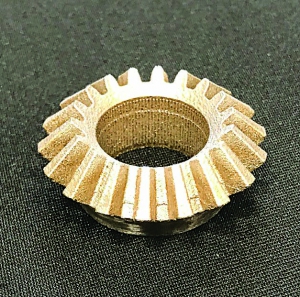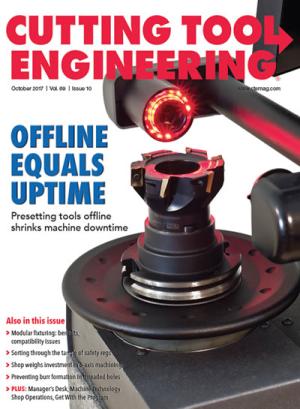With its new EOS M 290 additive-manufacturing system, Indiana Technology and Manufacturing Cos. (ITAMCO) now 3D-prints medical devices. After obtaining the system in June, the company started shipping components in August.
The fast ramp-up was partially because of the experience Plymouth, Ind.-based ITAMCO gained while contributing to the development of AM software called Atlas 3D, which a division of ITAMCO markets. The company was part of a consortium of manufacturers and universities that collaborated to develop the program through America Makes, a multimillion-dollar U.S. government-sponsored manufacturing initiative.
Another reason for ITAMCO’s efficient entry into AM was EOS GmbH, Krailling, Germany.

A 3D-printed bevel gear created with the EOS M 290 printer. Image courtesy of ITAMCO
“The EOS printer is the right tool for our complex components made with DMLS [direct metal laser sintering], and the EOS team trained our staff and got us up and running quickly,” said Joel Neidig, director of R&D at ITAMCO. “The printer works seamlessly with Atlas 3D too.”
Jon Walker, area sales manager at EOS North America, said ITAMCO is an ideal partner for EOS.
“Three generations of ITAMCO leaders have supplied traditional subtractive-manufactured parts to some of the best-known organizations in the world,” he said. “Due to their reputation, ITAMCO’s investment in additive manufacturing validates the 3D-printing market, especially in highly regulated industries where testing and validation of components or devices is critical.”
The medical device industry is a relatively new market for ITAMCO, which has served heavy-duty industries for decades.
“Additive manufacturing is allowing us to do things we’ve not done before, like producing the smaller, more intricate components for the medical device industry,” Neidig said.
When creating 3D-printed parts, ITAMCO tries as much as possible to minimize the subtractive work required later on the items.
“When you’re doing a build, you try to minimize the machining so you have less processing,” Neidig said. “From a subtractive standpoint, sometimes it’s significant in terms of what needs to be removed. You have to basically saw-cut or EDM off the build plate, and then once you do that, the part could require grinding. Or sometimes [operators] break the support structure off with pliers. Or sometimes it requires machining, such as turning or milling.”
Given ITAMCO’s proximity to numerous medical implant manufacturers in Indiana, such as those in nearby Warsaw, entering this industry is logical.
“We’ve hired two people from medical device companies to work for us,” Neidig said. “Of course, we will continue to expand our presence in our current markets by offering additive manufacturing and the high-quality subtractive manufacturing that made us so successful.”
Contact Details
Related Glossary Terms
- electrical-discharge machining ( EDM)
electrical-discharge machining ( EDM)
Process that vaporizes conductive materials by controlled application of pulsed electrical current that flows between a workpiece and electrode (tool) in a dielectric fluid. Permits machining shapes to tight accuracies without the internal stresses conventional machining often generates. Useful in diemaking.
- gang cutting ( milling)
gang cutting ( milling)
Machining with several cutters mounted on a single arbor, generally for simultaneous cutting.
- grinding
grinding
Machining operation in which material is removed from the workpiece by a powered abrasive wheel, stone, belt, paste, sheet, compound, slurry, etc. Takes various forms: surface grinding (creates flat and/or squared surfaces); cylindrical grinding (for external cylindrical and tapered shapes, fillets, undercuts, etc.); centerless grinding; chamfering; thread and form grinding; tool and cutter grinding; offhand grinding; lapping and polishing (grinding with extremely fine grits to create ultrasmooth surfaces); honing; and disc grinding.
- milling
milling
Machining operation in which metal or other material is removed by applying power to a rotating cutter. In vertical milling, the cutting tool is mounted vertically on the spindle. In horizontal milling, the cutting tool is mounted horizontally, either directly on the spindle or on an arbor. Horizontal milling is further broken down into conventional milling, where the cutter rotates opposite the direction of feed, or “up” into the workpiece; and climb milling, where the cutter rotates in the direction of feed, or “down” into the workpiece. Milling operations include plane or surface milling, endmilling, facemilling, angle milling, form milling and profiling.
- turning
turning
Workpiece is held in a chuck, mounted on a face plate or secured between centers and rotated while a cutting tool, normally a single-point tool, is fed into it along its periphery or across its end or face. Takes the form of straight turning (cutting along the periphery of the workpiece); taper turning (creating a taper); step turning (turning different-size diameters on the same work); chamfering (beveling an edge or shoulder); facing (cutting on an end); turning threads (usually external but can be internal); roughing (high-volume metal removal); and finishing (final light cuts). Performed on lathes, turning centers, chucking machines, automatic screw machines and similar machines.


